Bees are incredibly important pollinators that help to increase genetic diversity in plants and boost garden harvests too. However, due to habitat loss and fragmentation, changing climate patterns, and the increased use of pesticides, bee populations are declining. That’s why backyard pollinator habitats are becoming increasingly important for bee health and survival.
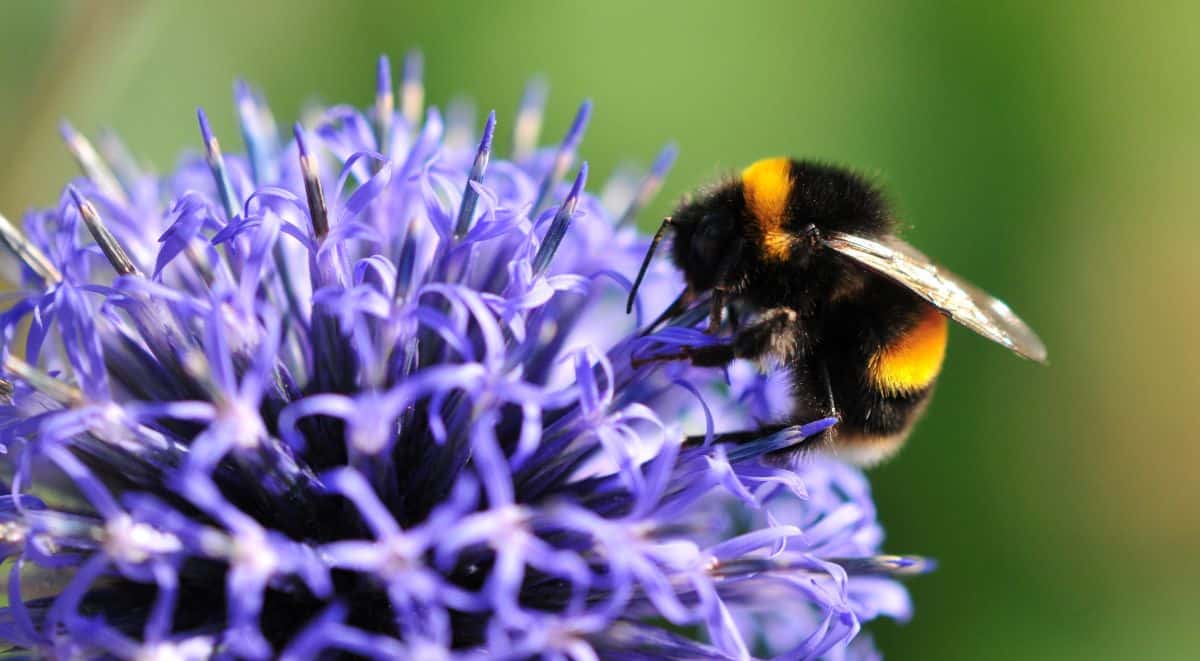
Keeping your garden organic and providing areas for bees to shelter in are both important practices to make your backyard more bee-friendly. But one of the best ways to help bees and encourage them to visit your garden space is to plant native plants and other nectar and pollen-rich specimens that bees love.
Below are some of the absolute best plants for bees. Sowing these plants in your garden will attract bees to your space and may even help bee populations make a comeback. Read on to learn all about the best pollinator-friendly plants for your bee garden!
Jump to:
- 20 best flowers to grow for bees
- 1. Bee balm (Monarda spp.)
- 2. Goldenrod (Solidago spp.)
- 3. New England aster (Symphyotrichum novae-angliae)
- 4. Joe Pye weed (Eutrochium purpureum)
- 5. Black-eyed Susan (Rudbeckia hirta)
- 6. Purple coneflower (Echinacea purpurea)
- 7. Liatris (Liatris spicata)
- 8. Sage (Salvia officinalis)
- 9. Alliums (Allium spp.)
- 10. Sunflower (Helianthus spp.)
- 11. Catmint (Nepeta racemosa)
- 12. Lobelia (Lobelia spp.)
- 13. Poppy (Papaver spp.)
- 14. Salvia (Salvia spp.)
- 15. Lilac (Syringa vulgaris)
- 16. Beardtongue (Penstemon spp.)
- 17. Sweet alyssum (Lobularia maritima)
- 18. Lavender (Lavandula spp.)
- 19. Sedum (Sedum spp.)
- 20. Yarrow (Achillea millefolium)
- Summary
20 best flowers to grow for bees
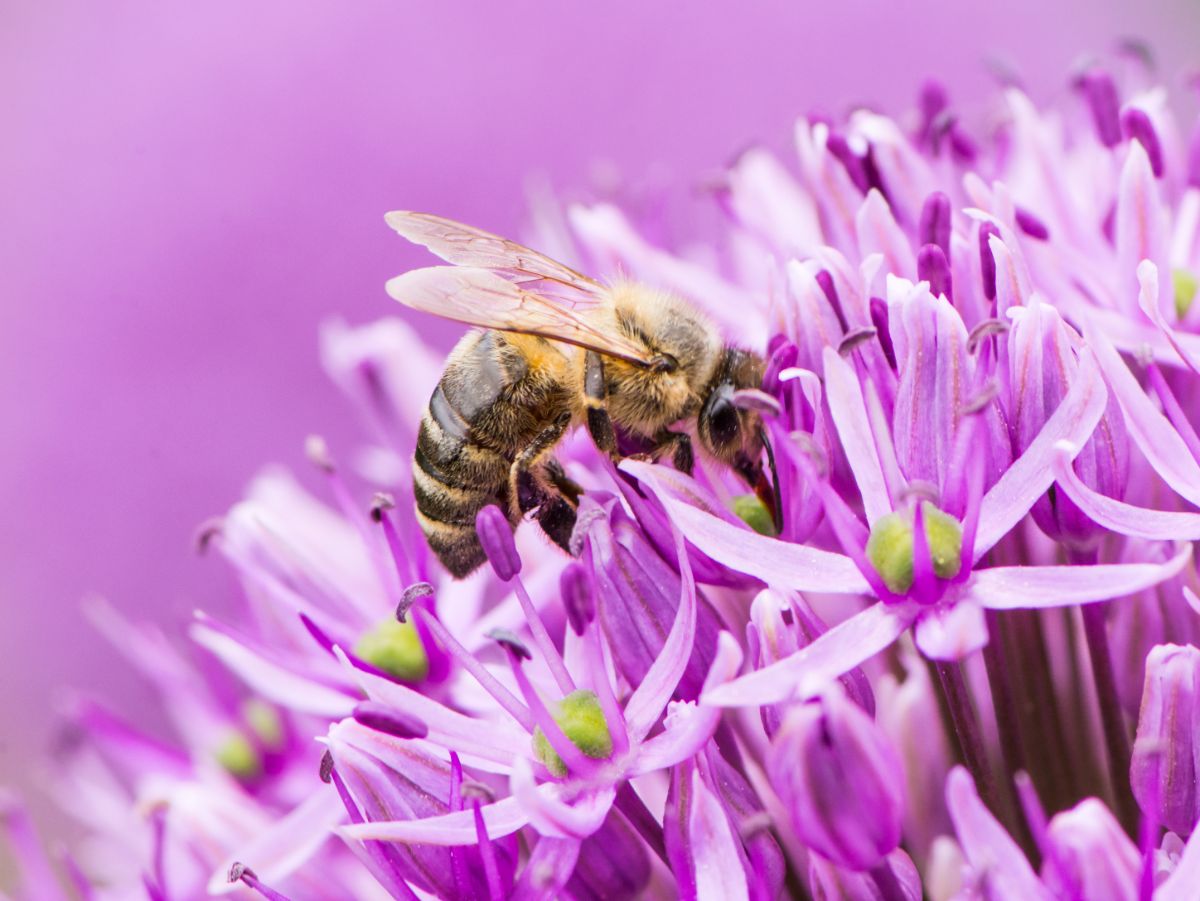
The best plants for bees tend to be native annuals and perennials, but flowering herbs are also popular pollinator plants. In the following list, we’ve compiled some of the best bee-friendly plants around. Try planting a few different species in your garden to give bees a bit of variety and increase the chances that you’ll attract lots of bees and other pollinators too!
1. Bee balm (Monarda spp.)
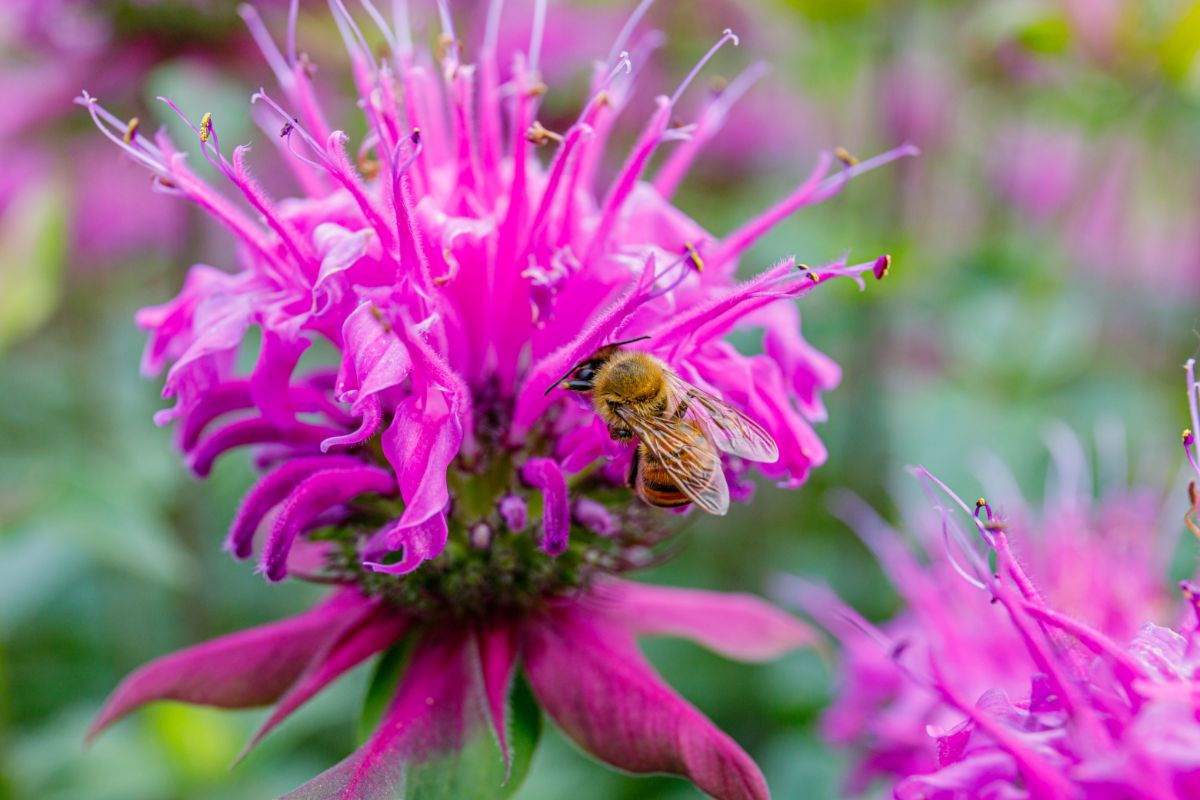
| Plant name: | Bee balm |
| Light requirements: | Full sun to part shade |
| Water requirements: | Moderate |
| Perennial or annual? | Perennial |
| Growing zone: | Zones 3 to 9 |
With a name like a bee balm, it should be no surprise that bees can’t resist this plant! Bee balm blooms in July and continues to flower through the end of summer. Spiky flowers look a bit like miniature fireworks with petals in white, purple, pink, and red.
Bee balm grows to about 4’ tall, although smaller, dwarf varieties are available that are perfect for container planters. Relatively drought tolerant, bee balms are easy plants to grow, but they do need lots of bright light to look their best. Like other varieties of mint, bee balm can spread rapidly, so it’s a good idea to deadhead spent blooms if you don’t want them going to seed.
2. Goldenrod (Solidago spp.)
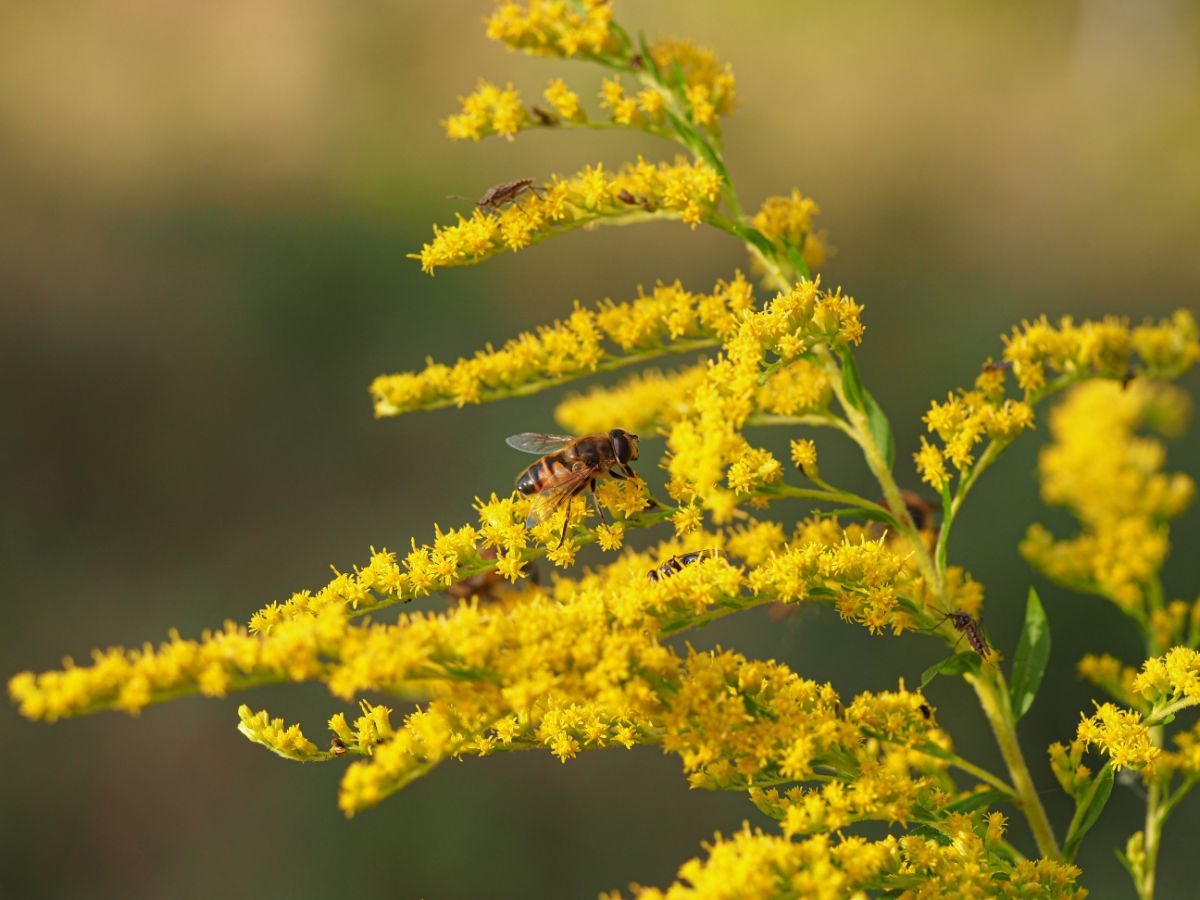
| Plant name: | Goldenrod |
| Light requirements: | Full sun |
| Water requirements: | Moderate to low |
| Perennial or annual? | Perennial |
| Growing zone: | Zones 2 to 8 |
A quintessential autumn plant, goldenrod is particularly important for bees and other pollinators as it supplies a good source of nectar and pollen later in the season after many other flowers fade. Goldenrod is a member of the Aster family and often blooms around the same time as New England asters. For this reason, many gardeners choose to plant these two plants together for lots of garden color.
There are about 120 different species of goldenrod today, some of which may naturally crop up in your garden all on their own. However, if you don’t have your own wild patch of goldenrod, you can start plants from seed or nursery starts. Sometimes gardeners are reluctant to plant goldenrod as they believe it causes allergies, but it’s actually the similar-looking ragweed that causes most allergy symptoms.
3. New England aster (Symphyotrichum novae-angliae)
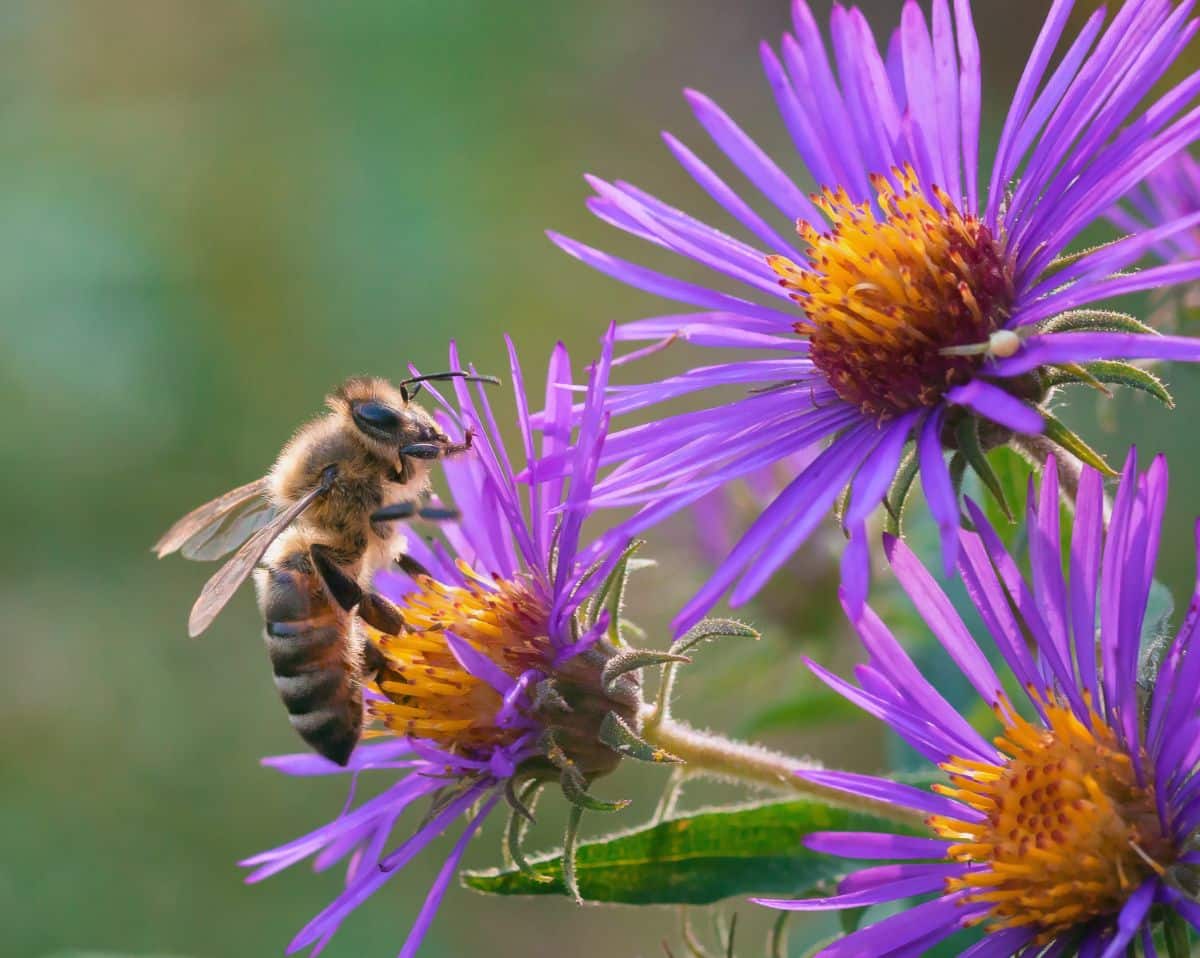
| Plant name: | New England aster |
| Light requirements: | Full sun to part shade |
| Water requirements: | High to moderate |
| Perennial or annual? | Perennial |
| Growing zone: | Zones 4 to 8 |
Like goldenrod, New England asters are a common sight in autumn gardens, and they may self-sow in your garden without you need to plant them. But if you don’t want to wait for nature, you can grow your own New England asters from seed. Just be sure to try out cold stratification if you do because this will greatly improve your germination rates!
New England asters look like tiny daisies with golden centers surrounded by a wealth of pink or purple petals. The open centers of these blooms make them well-suited for bees and other pollinators to feed from. New England asters are naturally resistant to deer, and they can tolerate part shade or full sun.
4. Joe Pye weed (Eutrochium purpureum)
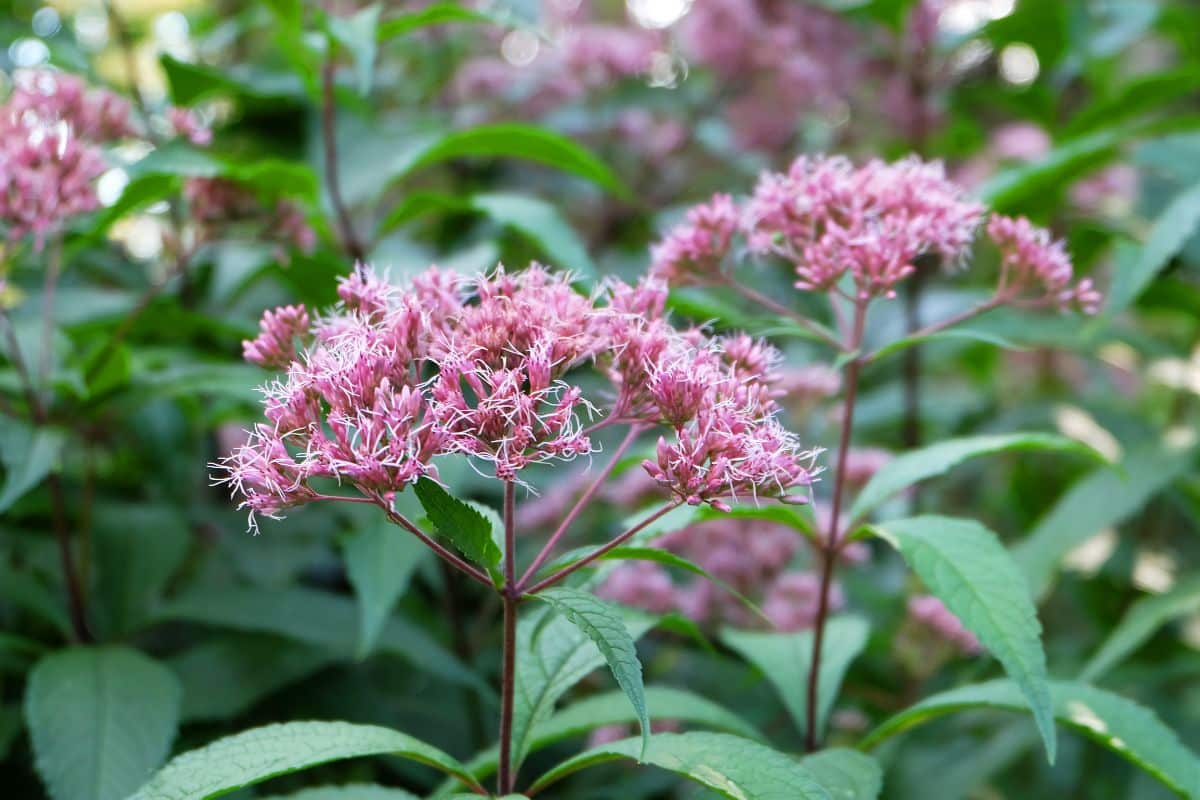
| Plant name: | Joe Pye weed |
| Light requirements: | Full sun to part shade |
| Water requirements: | High |
| Perennial or annual? | Perennial |
| Growing zone: | Zones 4 to 8 |
Joe Pye weed is a fragrant, sweet-smelling flowering plant that has a vanilla-like aroma that is irresistible to bees and many other pollinators. Native to North America, this low-maintenance plant is often spotted along streambanks and roadways, but it can be purchased as a nursery start or grown from seeds. Once established, Joe Pye weed grows in thick clumps, and flowers can stretch to about 7’ high.
Joe Pye weed can grow in different soil types, and it can handle full sun to part shade. That said, if your plant isn’t getting enough light, it may start to droop or produce fewer flowers. Since Joe Pye weed does best with consistently moist soil, you may want to add mulch around the base of your plant to slow evaporation rates and prevent the soil from drying out too quickly.
5. Black-eyed Susan (Rudbeckia hirta)
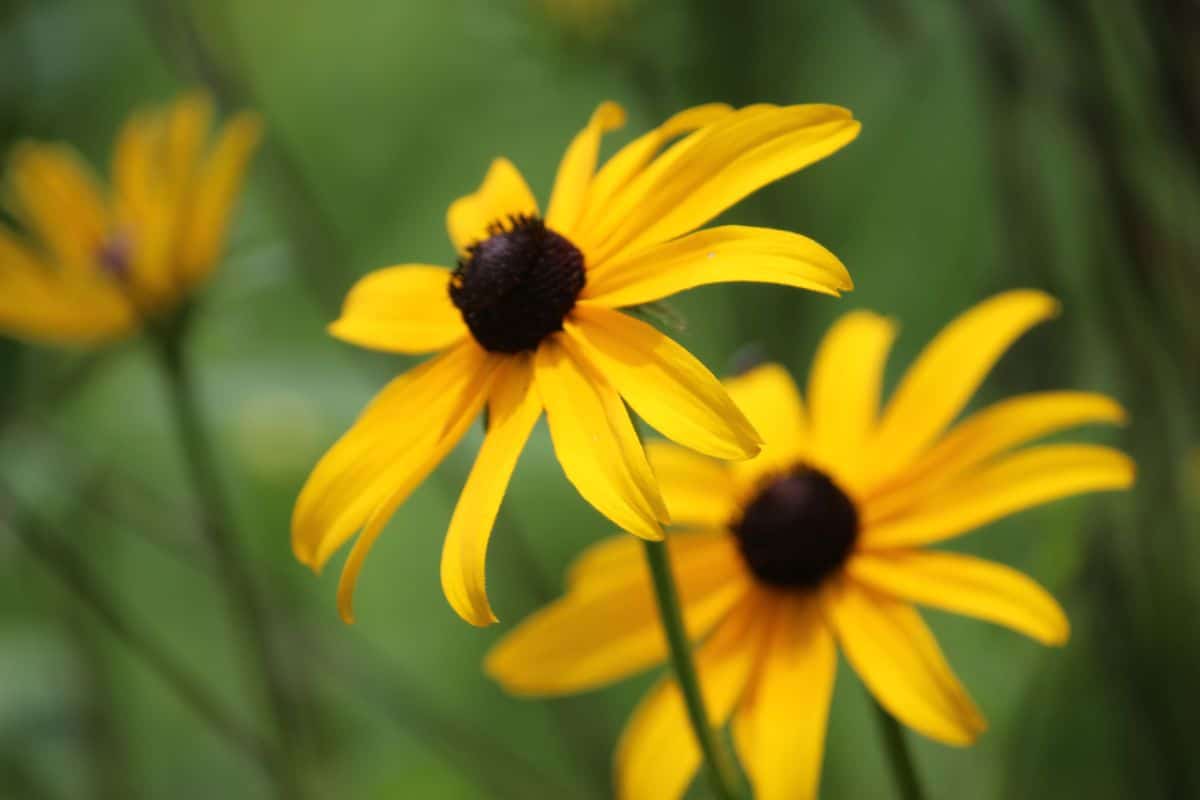
| Plant name: | Black-eyed Susan |
| Light requirements: | Full sun |
| Water requirements: | Moderate |
| Perennial or annual? | Perennial |
| Growing zone: | Zones 3 to 10 |
Cheery black-eyed Susan always lends a lighthearted feel to garden beds when they bloom in summer to autumn. Most commonly, black-eyed Susan features a chocolatey brown center surrounded by golden orange petals; however, different cultivars can have red, orange, or brown blooms. These lively plants pair beautifully with purple coneflowers, salvia, and catmint, which all have similar growing requirements as well.
In addition to being popular plants for bee gardens, black-eyed Susan are top picks among florists and work beautifully for homemade bouquet making. These low-maintenance plants are naturally resistant to deer and rabbits, and they can handle drought-like conditions too.
6. Purple coneflower (Echinacea purpurea)
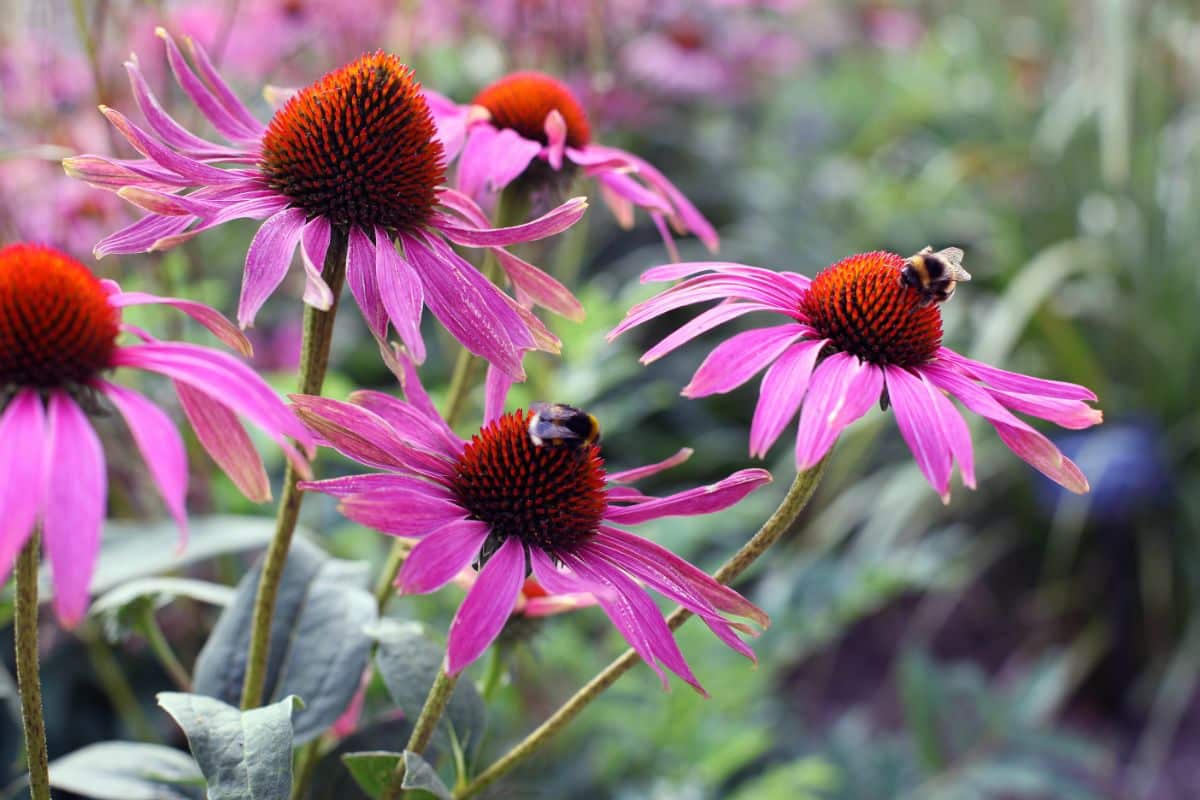
| Plant name: | Purple coneflower |
| Light requirements: | Full sun |
| Water requirements: | Moderate to low |
| Perennial or annual? | Perennial |
| Growing zone: | Zones 3 to 9 |
Purple coneflowers attract a wide variety of pollinators and beneficial insects, and bees love these plants as well! Part of the draw of purple coneflowers is due to their large open centers, which are easy for bees to feed from. And, of course, gardeners delight in the pretty purple petals of these plants that pair beautifully with black-eyed Susan and other garden favorites.
Purple coneflowers are low-maintenance plants that have a good deal of drought resistance, so they’re an ideal choice if you’re looking for a no-fuss plant. Purple coneflowers can be grown from nursery starts or seeds, but like many other wildflowers, seeds grow best when cold-stratified.
7. Liatris (Liatris spicata)
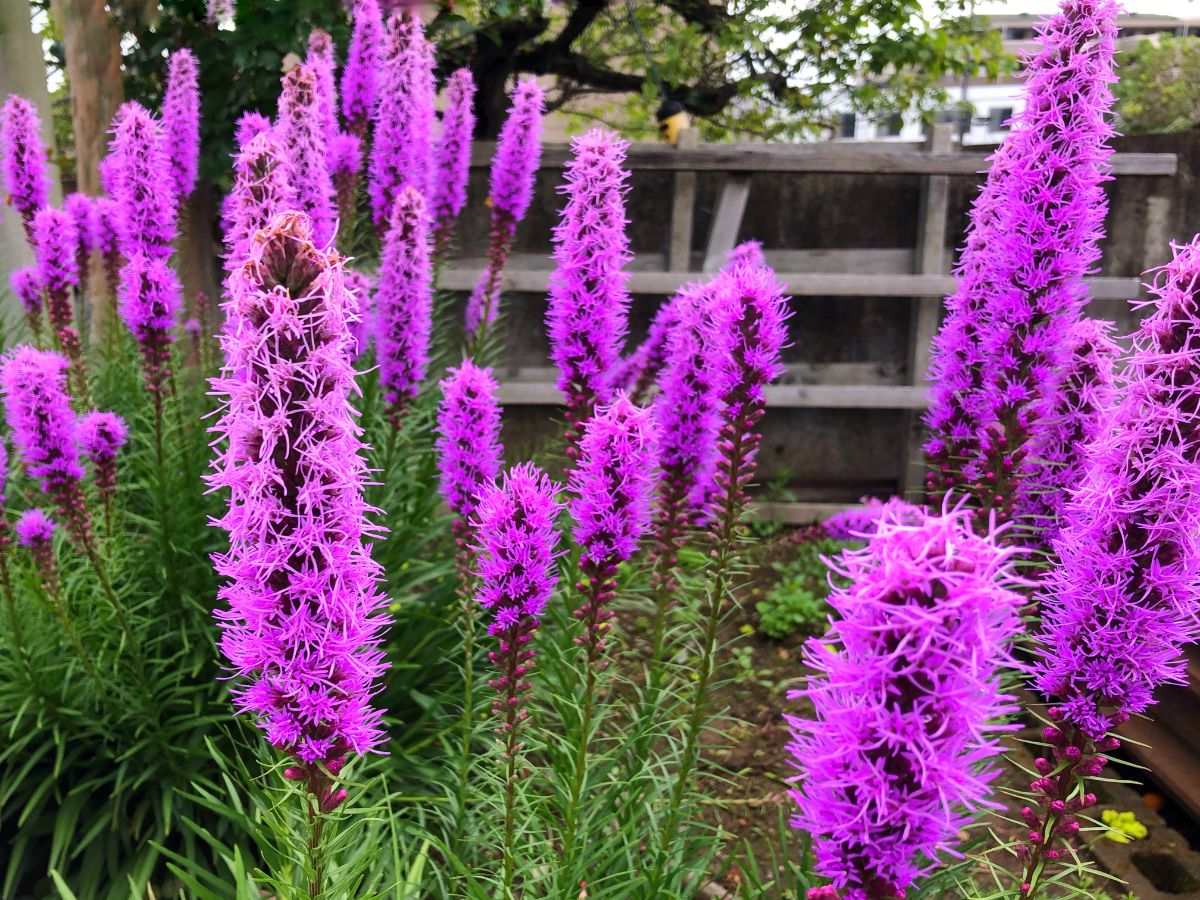
| Plant name: | Liatris |
| Light requirements: | Full sun |
| Water requirements: | Low |
| Perennial or annual? | Perennial |
| Growing zone: | Zones 3 to 8 |
Also known as gayfeather or blazing star, Liatris are another bee favorite. These plants are native to North America and are a variety of aster; however, unlike most asters, they feature a long, spire-shaped flower that is quite unusual. Liatris blooms are naturally purple in color, but you can find these plants in pink and white too.
Liatris is often grown from nursery starts or corms that are planted in spring. Plants grow quickly and usually flower within the first year, but they may take longer if you choose to start these plants from seed. Plants produce grass-like leaves and are generally very easy to keep, although they may require staking if you plant them in very rich soil.
8. Sage (Salvia officinalis)
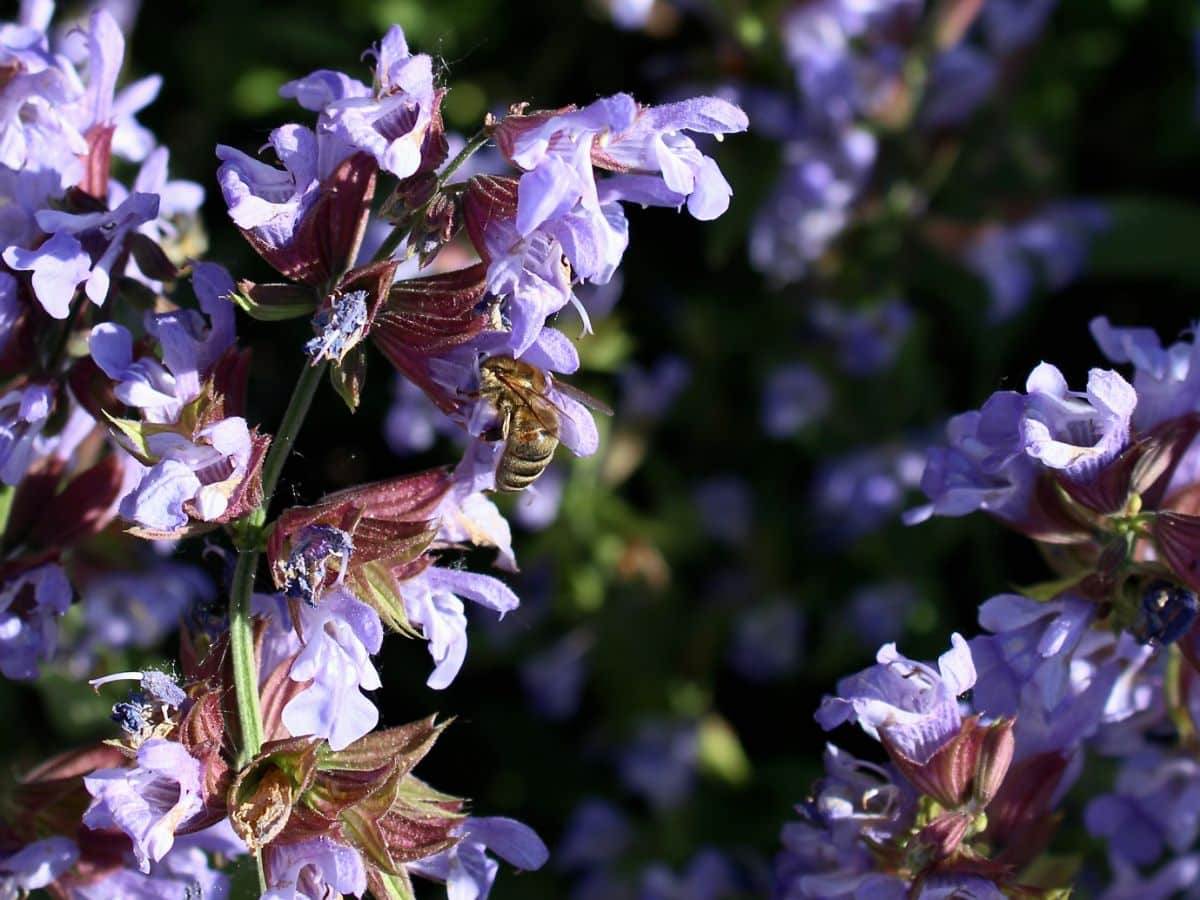
| Plant name: | Sage |
| Light requirements: | Full sun to part shade |
| Water requirements: | Low |
| Perennial or annual? | Perennial |
| Growing zone: | Zones 5 to 8 |
Common sage is a traditional choice in herb gardens, and it is a must-have in your spice cabinet too. But this plant is often overlooked as a pollinator favorite, which is a shame because bees absolutely adore its pretty purple flowers!
When allowed to bloom, sage is absolutely irresistible to a wide range of insects, and it’s one of the best plants to grow if you want to keep a pollinator garden but you only have a small space to work with. Sage can be grown inground or in pots, and there are many attractive varieties to choose from, including purple sage and tricolor sage. Once in bloom, sage may produce fewer leaves for harvesting, but that’s a fair trade because these plants are just so good for bees!
9. Alliums (Allium spp.)
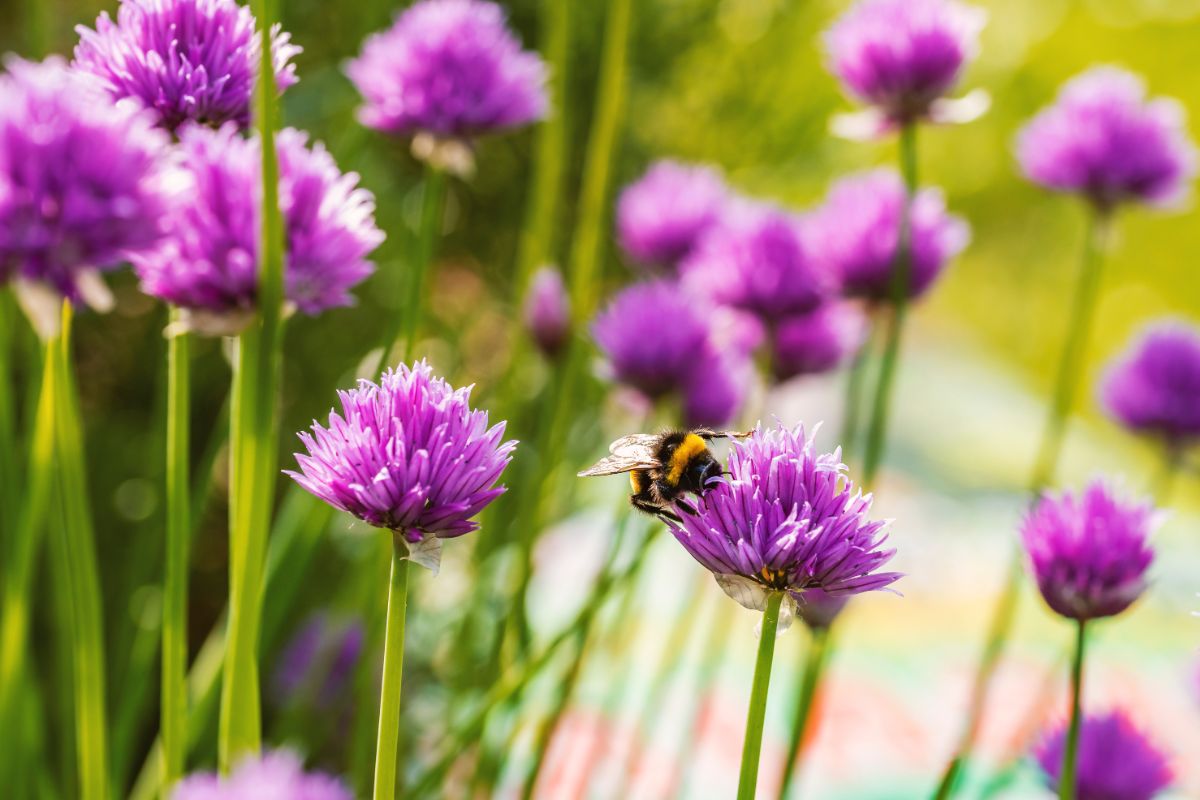
| Plant name: | Alliums |
| Light requirements: | Full sun to part shade |
| Water requirements: | Low |
| Perennial or annual? | Perennial |
| Growing zone: | Zones 3 to 9 |
In addition to sage, many other herbs make wonderful pollinator plants if they are allowed to bloom. Alliums are another exceptional flowering herb for attracting bees, and this plant family includes onions, garlic, leeks, chives, and ornamental alliums.
Allium flowers are uniquely shaped and often form globular blooms that add a fun and whimsical aspect to planting arrangements. Flowers range in color from purples and pinks to white and pair beautifully with sunflowers, black-eyed Susan, and other plants with warm-toned blooms. If you have wild garlic or onions growing on your property, they will also attract lots of bees when they flower!
10. Sunflower (Helianthus spp.)

| Plant name: | Sunflower |
| Light requirements: | Full sun |
| Water requirements: | Moderate |
| Perennial or annual? | Annual |
| Growing zone: | Zones 4 to 9 |
Sunflowers look like summertime with their big, wide-open flowers and warm, golden-yellow petals. The wide faces of these flowers make them very easy for bees and other pollinators to forage from, so don’t be surprised if you see your sunflowers absolutely swarming with bees during the growing season! Even after the flowers fade, birds will be attracted to the seeds, and you’ll need to harvest them quickly if you want to save any sunflower seeds for yourself!
While sunflowers are often golden in color, you can find sunflowers in lots of other hues, too, including maroon and bright white. Sunflowers can range in size from mammoth sunflowers that stretch well over 9’ tall to smaller dwarf varieties that work well in pots. Planting sunflowers in your vegetable garden will also help lure bees to your plants and boost pollination rates and harvest yields too.
11. Catmint (Nepeta racemosa)
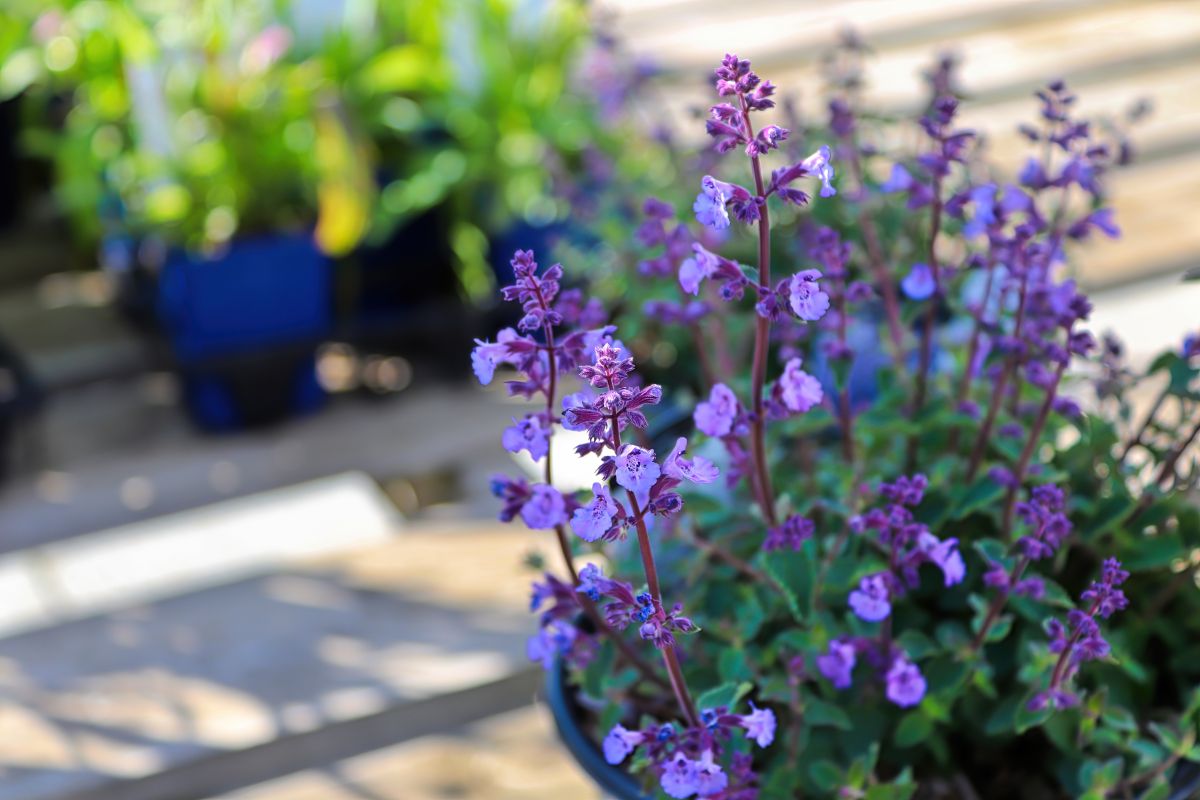
| Plant name: | Catmint |
| Light requirements: | Full sun to part shade |
| Water requirements: | Low |
| Perennial or annual? | Perennial |
| Growing zone: | Zones 3 to 8 |
Catmint is an attractive plant with tall spires of purple, white, or pink flowers that bees will congregate to. Flowers begin to bloom in early summer and may have several flushes of flowers throughout the remainder of the growing season. Catmint leaves often have a silvery-green tone to them that lends a delicate and feminine quality to planting arrangements.
Catmint is closely related to catnip, but cats tend to be less reactive to this plant. Catmint is a member of the mint family and is quite easy to grow. However, it may spread rapidly, which is why many gardeners keep it in containers and raised beds.
12. Lobelia (Lobelia spp.)
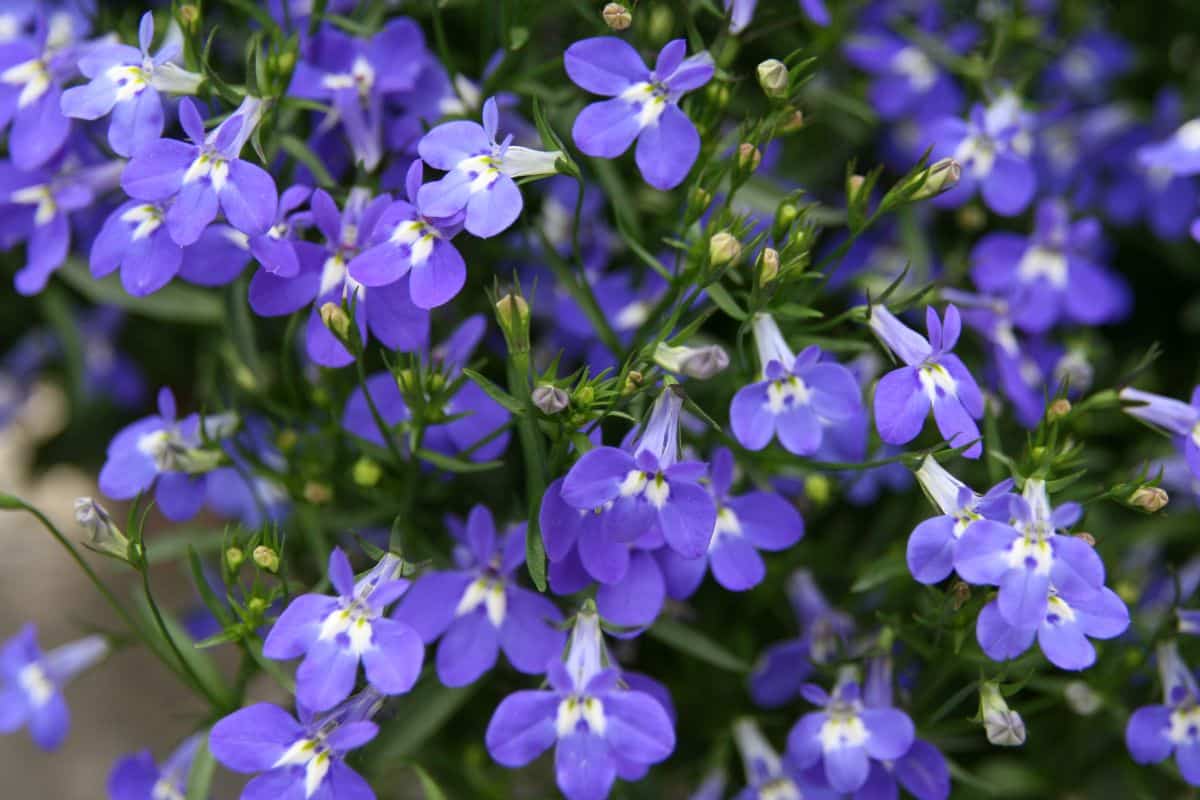
| Plant name: | Lobelia |
| Light requirements: | Full sun to part shade |
| Water requirements: | High |
| Perennial or annual? | Perennial |
| Growing zone: | Zones 9 to 11 |
Lobelia is technically a tender perennial, but it is usually grown as an annual in most cooler areas. Easy to find at plant nurseries, you can also grow lobelia from seed. There are many different varieties of lobelia to choose from, including cultivars that have a more trailing growth habit that is perfect for containers and hanging baskets.
Most commonly, lobelia blooms are a deep blue color, but you can find varieties in purple, pink, and white. Often, flowers are also embellished with some white dots and accents that only add to their charm. Lobelia flowers are much beloved by bees, as well as other pollinators and hummingbirds.
13. Poppy (Papaver spp.)
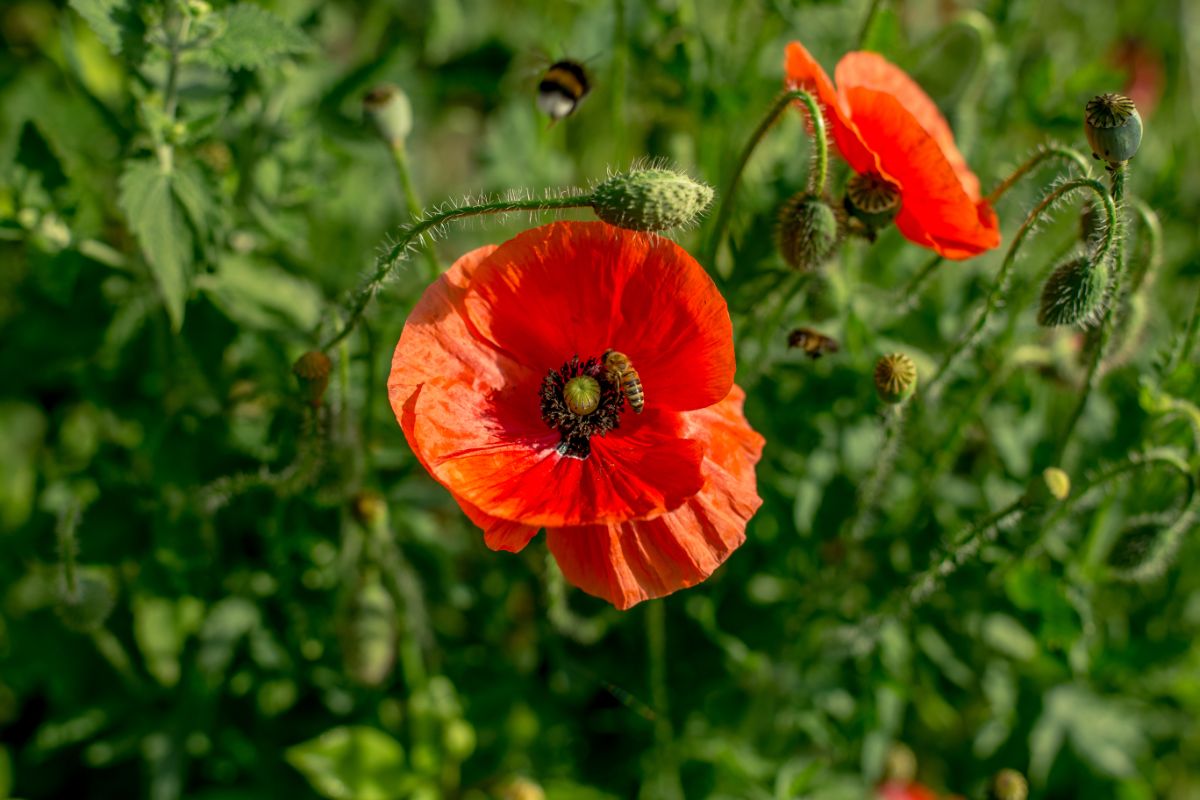
| Plant name: | Poppy |
| Light requirements: | Full sun |
| Water requirements: | Moderate |
| Perennial or annual? | Both |
| Growing zone: | Zones 4 and up |
Poppies are very symbolic plants that are often used in floral arrangements and art to signify remembrance. Traditionally, they are especially symbolic of WWI. In the garden, poppies add charm and sophistication to flower beds, and they are also irresistible to many pollinators.
There are lots of different poppy varieties to choose from, although most have fine and delicate petals that are so papery thin that they allow sunlight to shine through them. Any pollen-rich poppy variety will make an excellent addition to pollinator gardens. Some top choices include Icelandic poppies, bread seed poppies, and California poppies.
14. Salvia (Salvia spp.)
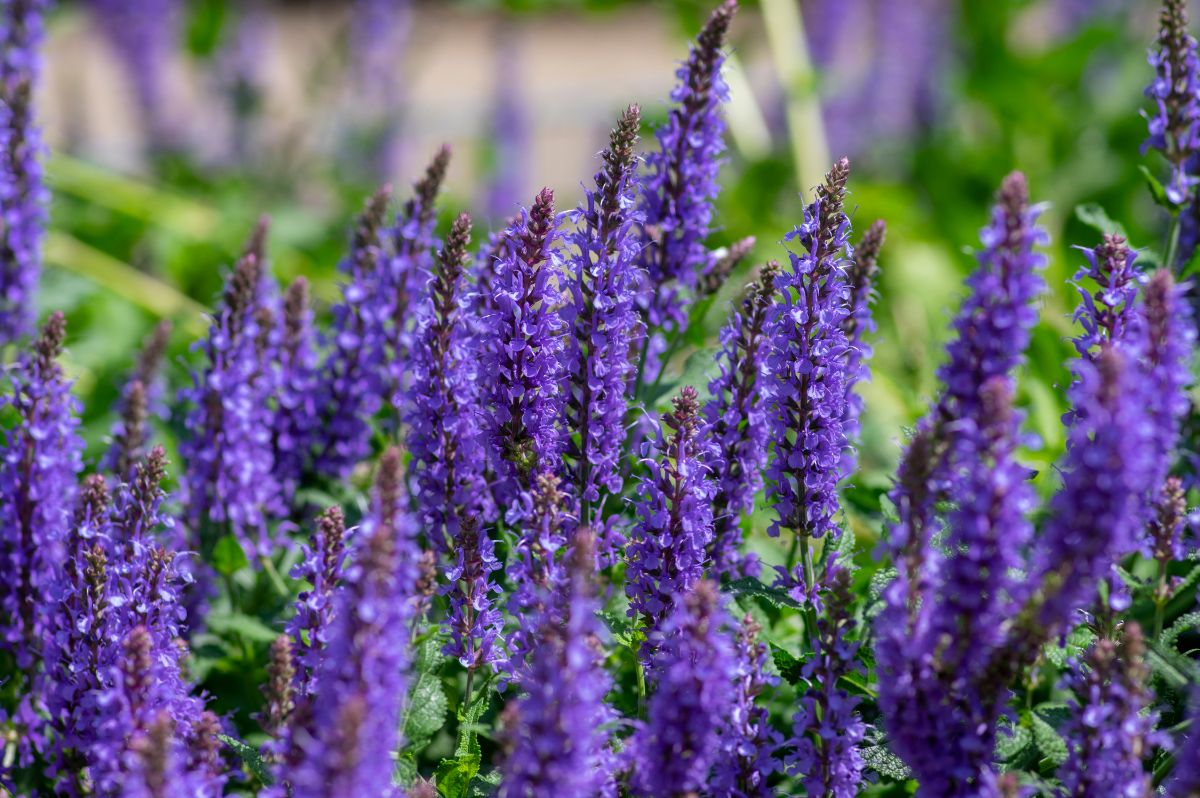
| Plant name: | Salvia |
| Light requirements: | Full sun |
| Water requirements: | Moderate to low |
| Perennial or annual? | Both |
| Growing zone: | Zones 5 to 9 |
Common sage is actually a variety of salvia, although there are many other types of salvia, and most of them are grown for purely ornamental purposes. Salvia is an excellent food source for bees, and different cultivars will bloom from spring through fall, providing lots of nectar and pollen for insects. You can find both annual and perennial varieties of salvia on the market today, and there are even some cultivars that grow into shrubs.
Salvia produces tall spikes of airy flowers, which come in purples, reds, and other colors. Able to grow in even rocky or nutrient-poor soil, salvias are hardy plants that have a good deal of drought resistance. Just make sure your plants receive plenty of bright sun and deadhead spent blooms in mid-summer to help your plants continue to look their best.
15. Lilac (Syringa vulgaris)
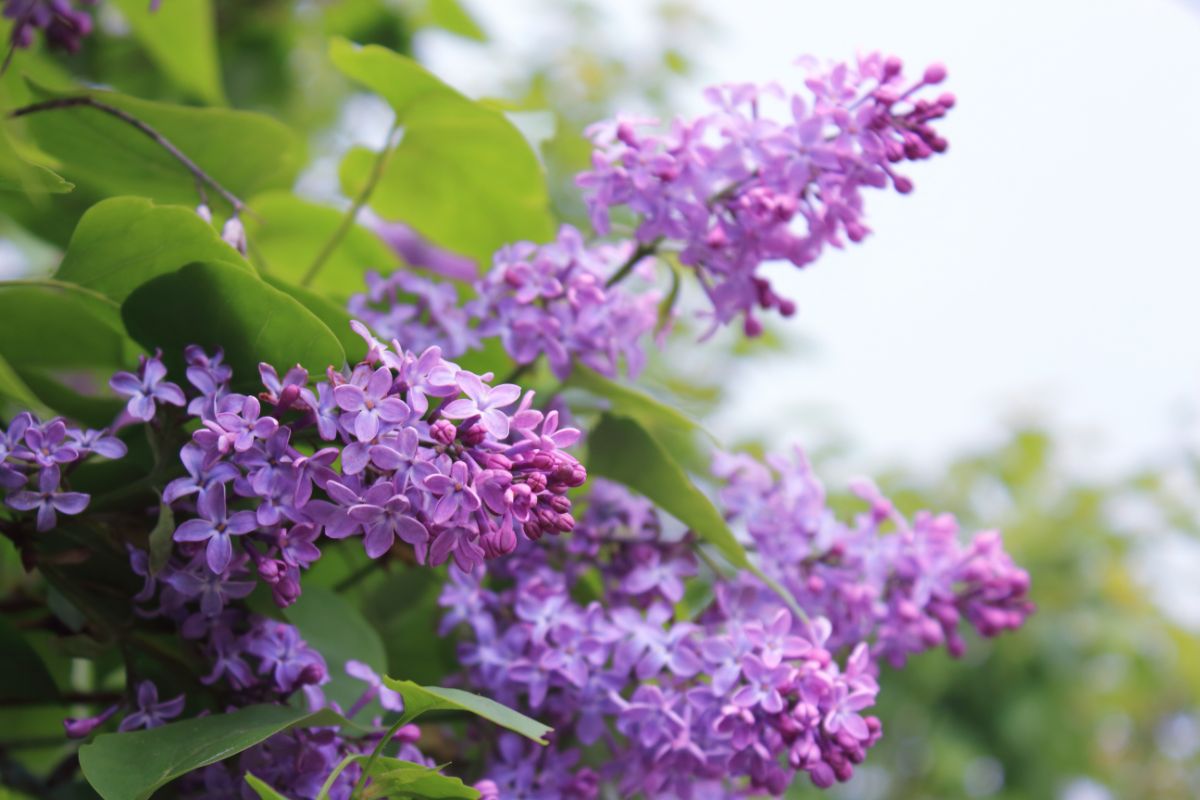
| Plant name: | Lilac |
| Light requirements: | Full sun |
| Water requirements: | Moderate |
| Perennial or annual? | Perennial |
| Growing zone: | Zones 3 to 8 |
I always look forward to when my lilacs bloom, as it’s a sure sign that spring has finally arrived! Since lilacs are some of the first shrubs to flower after the winter, they provide an important source of nectar and pollen for bees who are recovering after the hardships of winter. But these plants are delightful for humans, too, and make gorgeous centerpieces when gathered into pitchers and vases for indoor enjoyment.
Lilacs are well known for their luscious fragrance, which has been used to inspire many perfume lines over the years. Clusters of tiny flowers can be found in purples, pinks, and white, and they complement the plant’s heart-shaped leaves beautifully. Standard lilacs can grow up to 30’ tall, although you can find dwarf varieties that are appropriate for small spaces as well.
16. Beardtongue (Penstemon spp.)
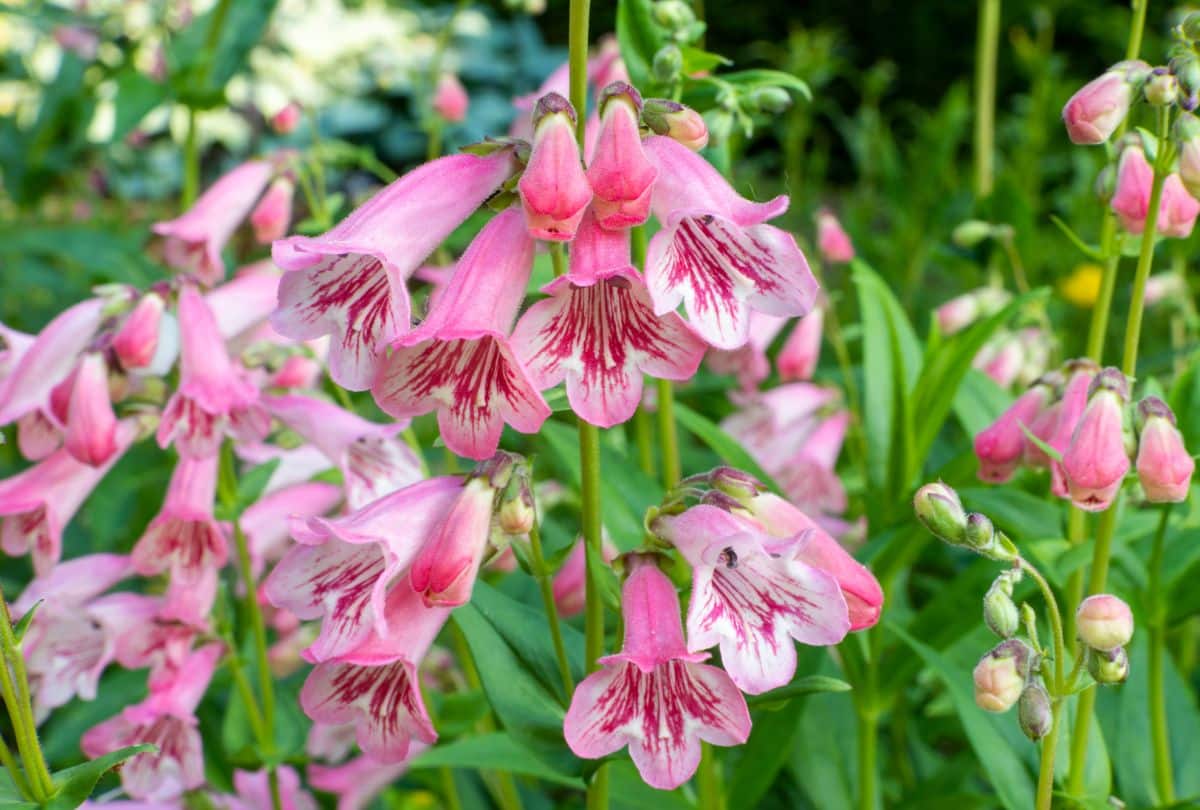
| Plant name: | Beardtongue |
| Light requirements: | Full sun |
| Water requirements: | Moderate |
| Perennial or annual? | Perennial |
| Growing zone: | Zones 3 to 8 |
Beardtongues are a member of the plantain family, which also includes foxgloves and snapdragons. There are over 250 different varieties of beardtongues, but most cultivars feature lance-shaped leaves and tubular flowers that are perfectly sized for foraging bees. Flowers come in different colors, including purple, pink, and red.
Beardtongues are named for their flower shape, which is slightly reminiscent of bearded irises. These plants can be purchased as nursery starts, but they are also easy to grow from seed. Just have a bit of patience if you grow these plants from seed, as they can take up to 3 weeks to germinate.
17. Sweet alyssum (Lobularia maritima)
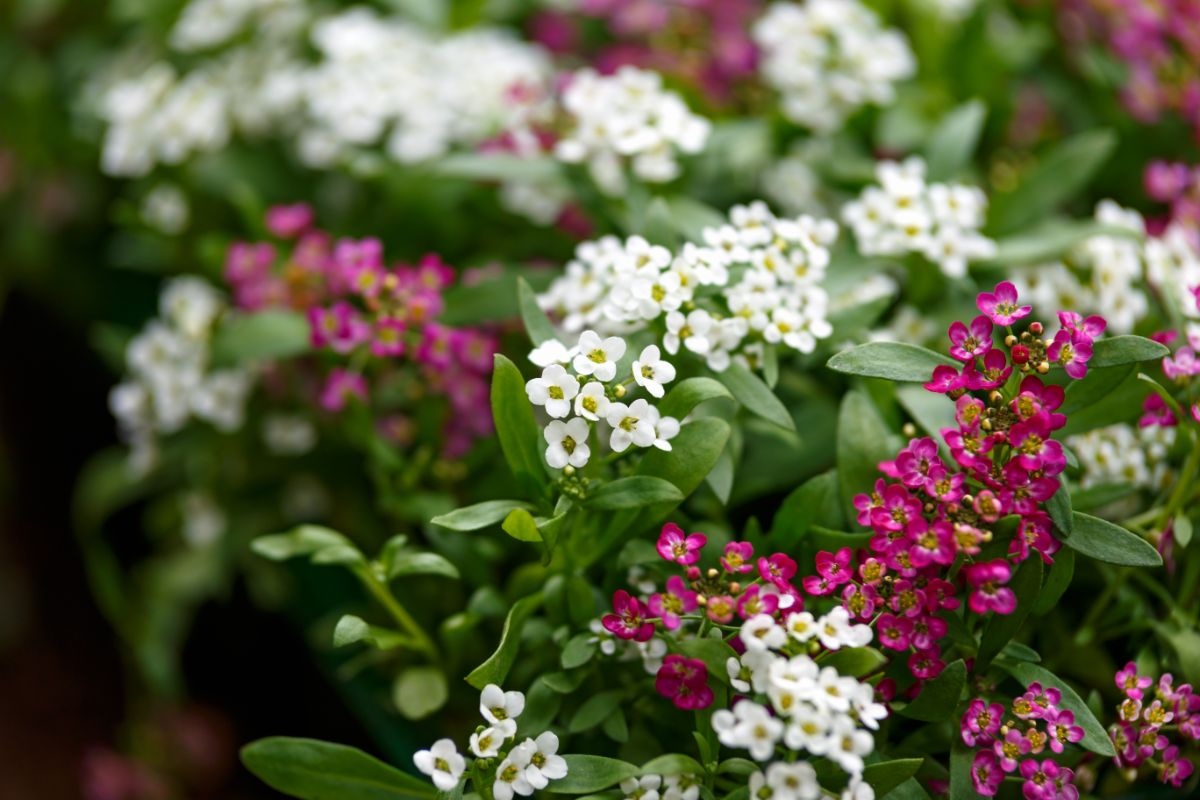
| Plant name: | Sweet alyssum |
| Light requirements: | Full sun to part shade |
| Water requirements: | Moderate |
| Perennial or annual? | Perennial |
| Growing zone: | Zones 5 to 9 |
Sweet alyssum is a low-growing plant that can be used as a ground cover, although it is often planted in containers where it forms the “spiller” element of ornamental designs. Flowers are small but highly attractive to pollinators and come in both purple and white.
Native to Europe, sweet alyssum is a cool season flower that usually blooms in spring. Flowers fade back during the heat of summer, and then the plant frequently reblooms in autumn when temperatures start to drop. These plants can be easily grown from seed and will begin to flower about two months after planting.
18. Lavender (Lavandula spp.)
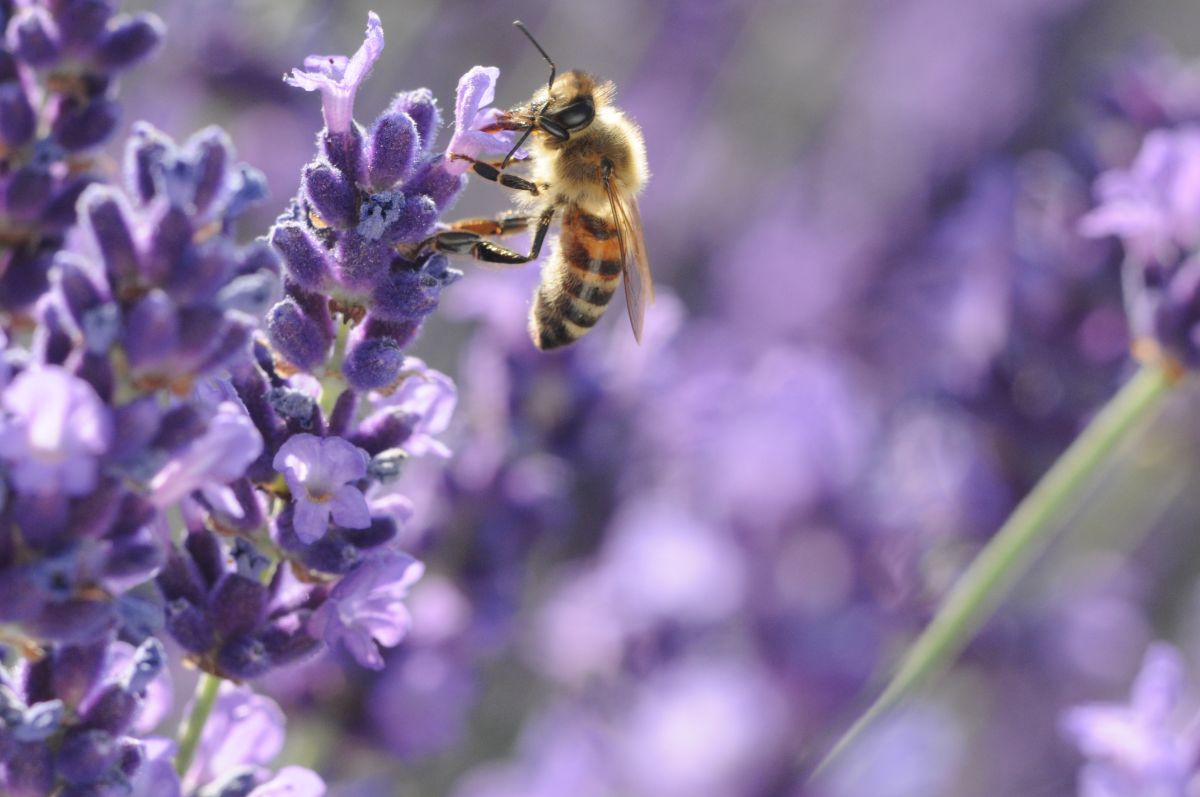
| Plant name: | Lavender |
| Light requirements: | Full sun |
| Water requirements: | Low |
| Perennial or annual? | Perennial |
| Growing zone: | Zones 5 to 9 (most varieties) |
Lavender can be brewed into herbal teas or infused into desserts, but it is also a top plant to grow if you want to attract bees and other pollinators. Lavender flowers bloom from July to August, providing a good source of food for bees as they ready themselves for the winter season. If you happen to keep bees for honey, growing lavender near your hives can help feed your bees and create wonderfully nuanced honey too!
There are many different varieties of lavender to choose from, including some that are more winter hardy than others. Lavender is a plant that doesn’t like a lot of moisture; however, if you live in a humid location, you can try out French lavender, which can handle humidity a bit better.
19. Sedum (Sedum spp.)
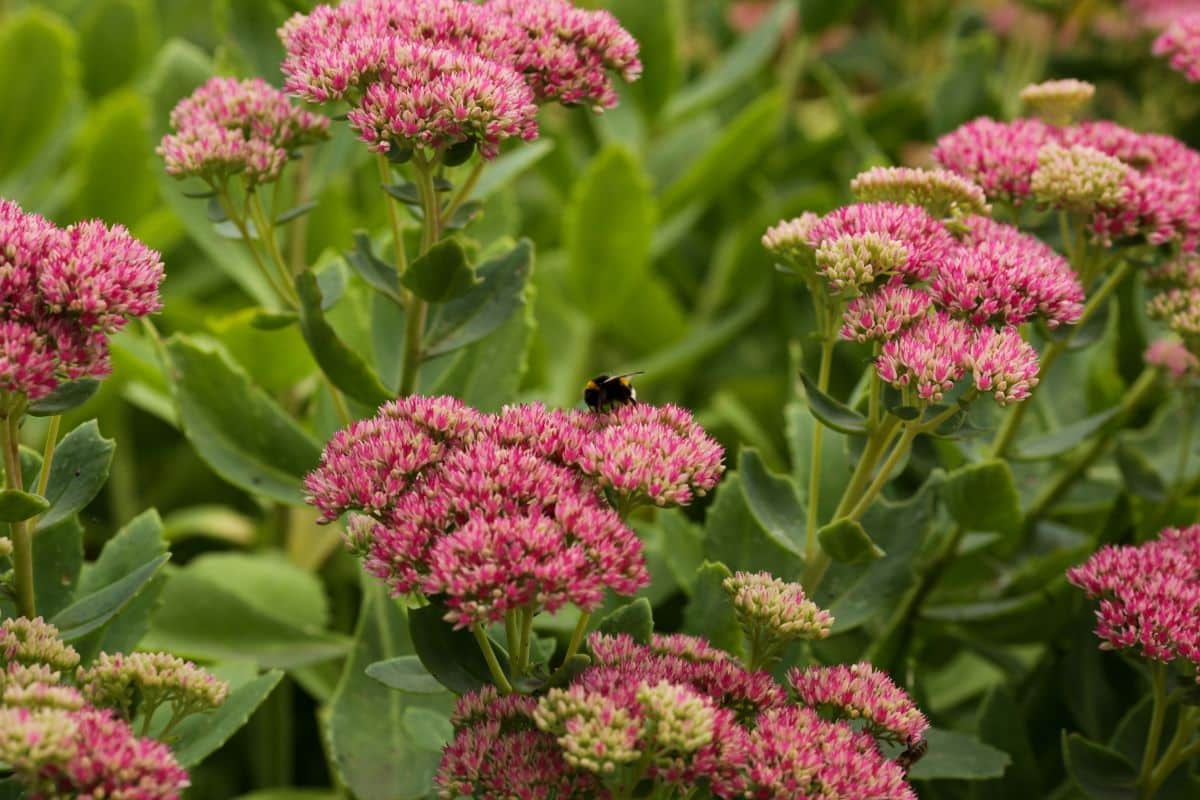
| Plant name: | Sedum |
| Light requirements: | Full sun |
| Water requirements: | Low |
| Perennial or annual? | Perennial |
| Growing zone: | Zones 3 to 11 |
Also known as stonecrop, sedums are late-blooming plants that are some of the last flowers in autumn gardens. That makes them an important food source for bees, as these plants can continue to bloom even after the first frost arrives. Sedums feature large, flat flowers that are easy for bees to feed from, and flowers come in reds, pinks, purples, and other colors.
As a variety of succulent, sedums don’t need a lot of water, which can be especially good news if you live in an area that is prone to drought. You can find sedums in a range of sizes as well, including lower-growing varieties that make wonderful groundcovers.
20. Yarrow (Achillea millefolium)
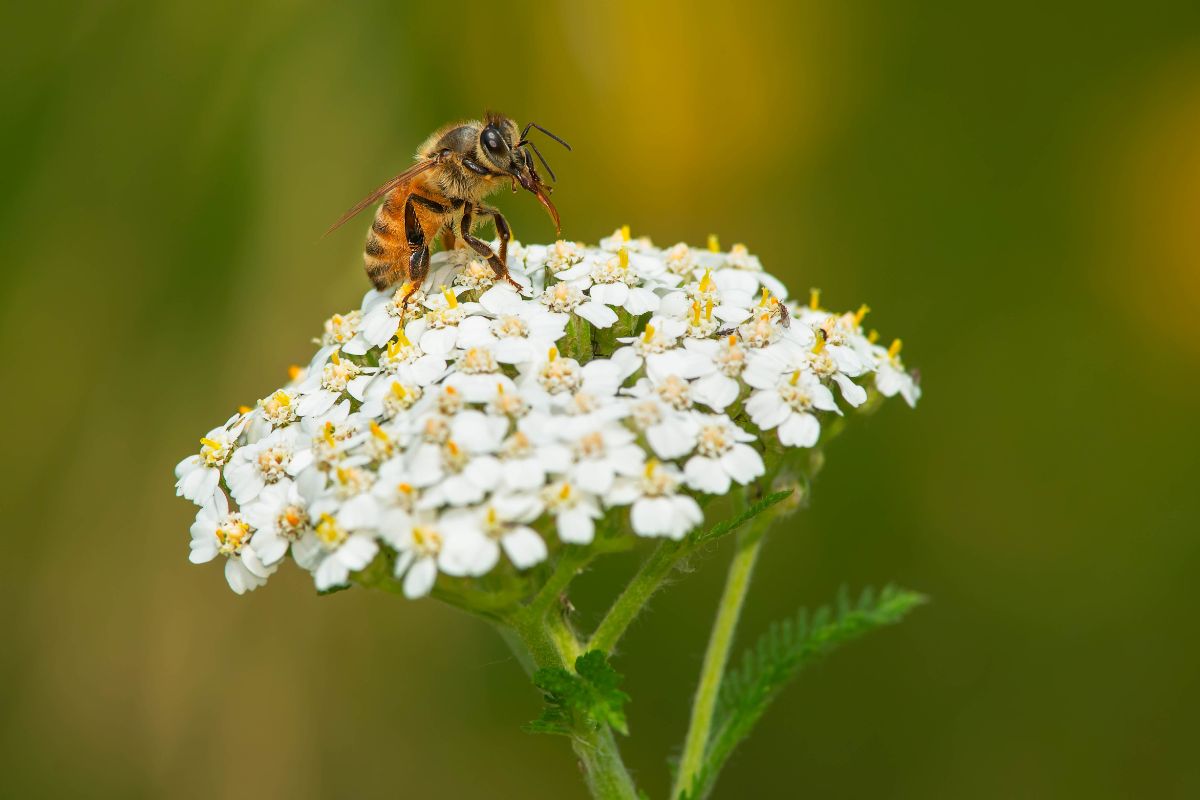
| Plant name: | Yarrow |
| Light requirements: | Full sun |
| Water requirements: | Low |
| Perennial or annual? | Perennial |
| Growing zone: | Zones 3 to 9 |
No pollinator garden is complete without a few yarrow plants. Hardy and resilient, yarrow is drought tolerant and naturally resistant to most pests, including deer. But it remains one of the best plants to grow if you want to attract bees to your backyard.
Yarrow plants have wide, flat flowers that make easy landing pads for bees, butterflies, and other pollinators to perch on when feeding. Flowers come in yellows, pinks, and reds and are complemented beautifully by the plant’s feathery foliage. Yarrow blooms also make exceptional dried flowers and cut flowers too!
Summary
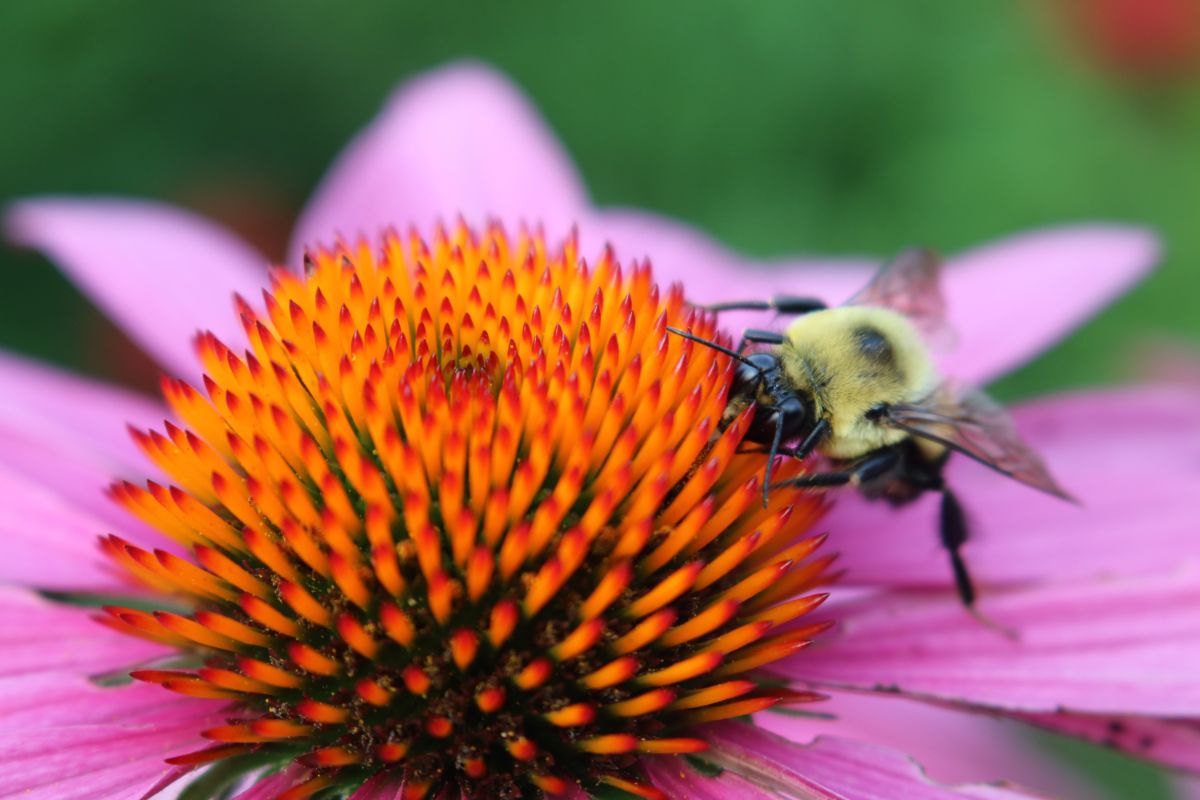
Beyond planting the right plants for bees, it’s important to include a variety of different flowers in your garden and plan for the entire growing season. Using the list above, we recommend choosing a few spring, summer, and fall-blooming plants to include in your landscape. And, of course, whenever possible, choose organic gardening methods to preserve your local bee populations.
We hope you liked this article! If you want to learn more about creating a pollinator habitat, read our guide on pollinator gardening here.


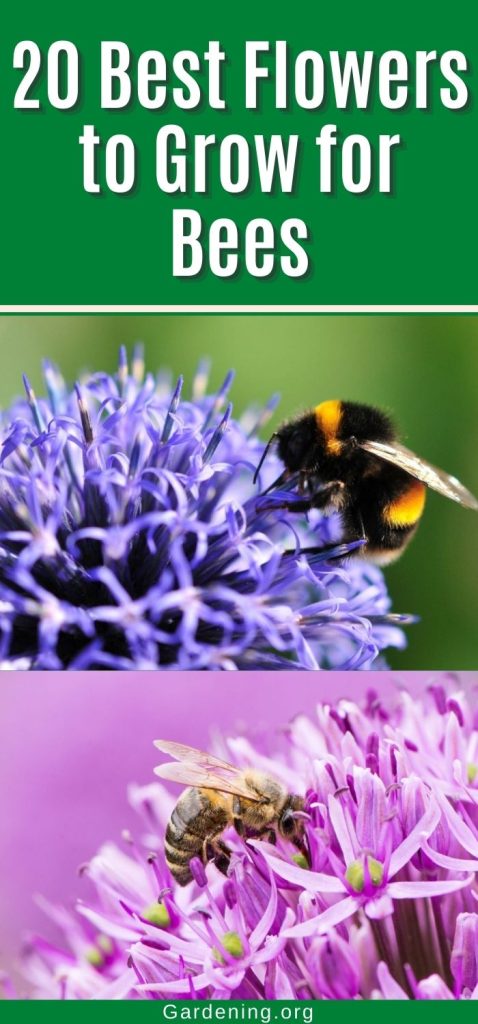
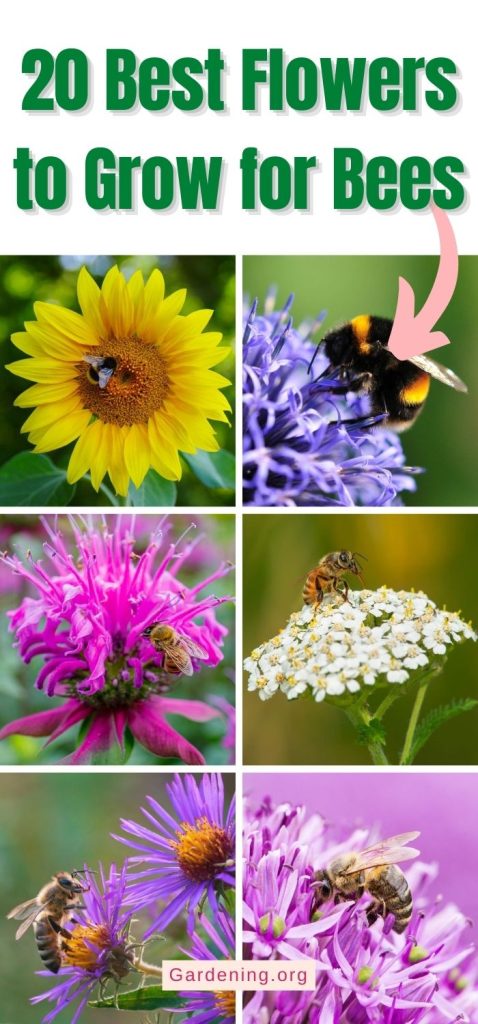
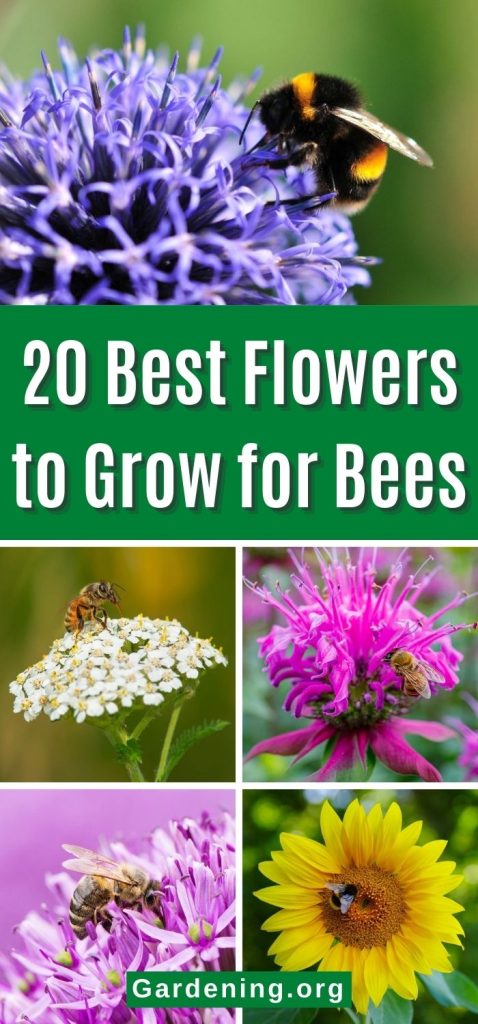

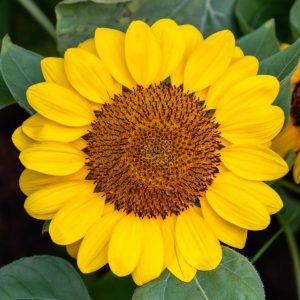
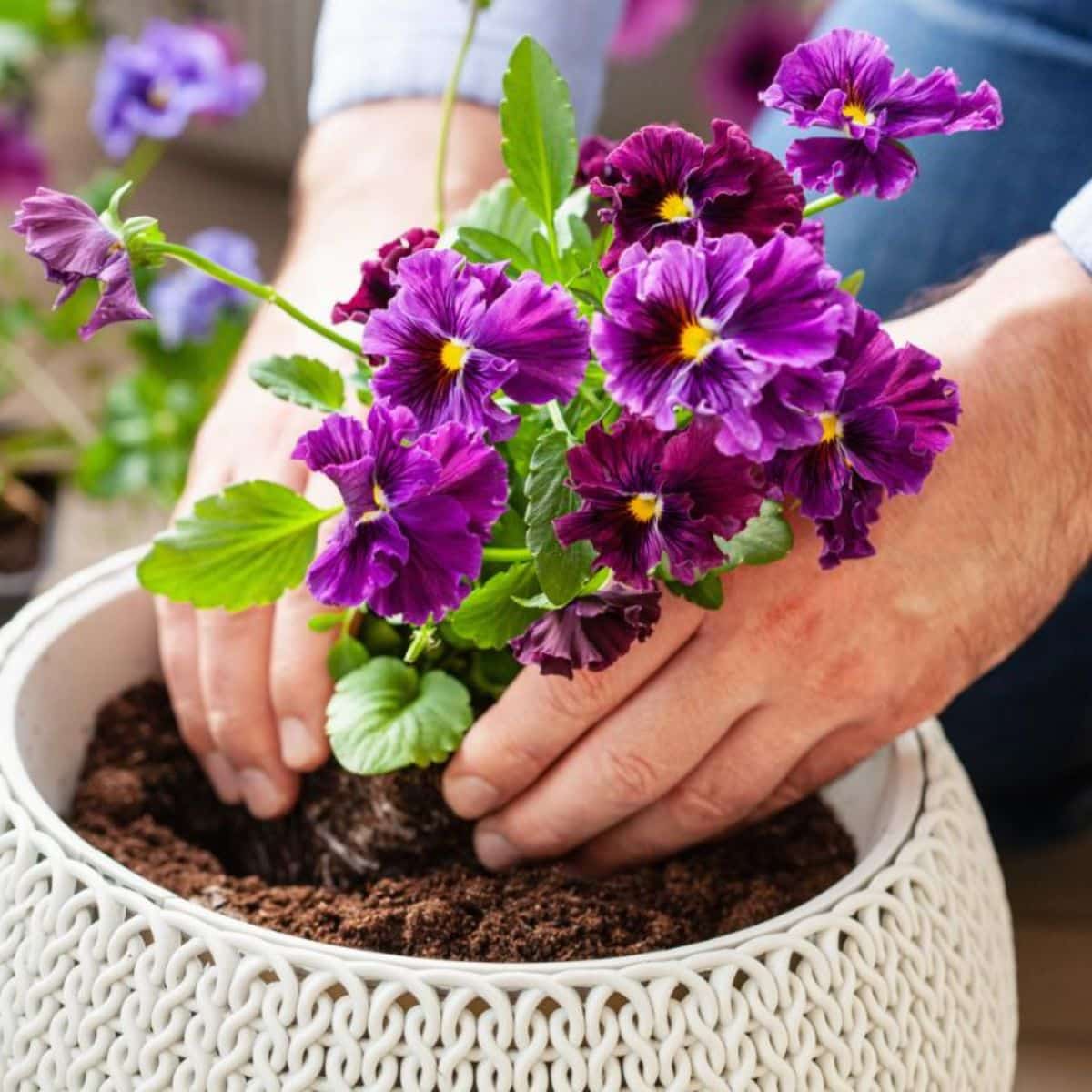
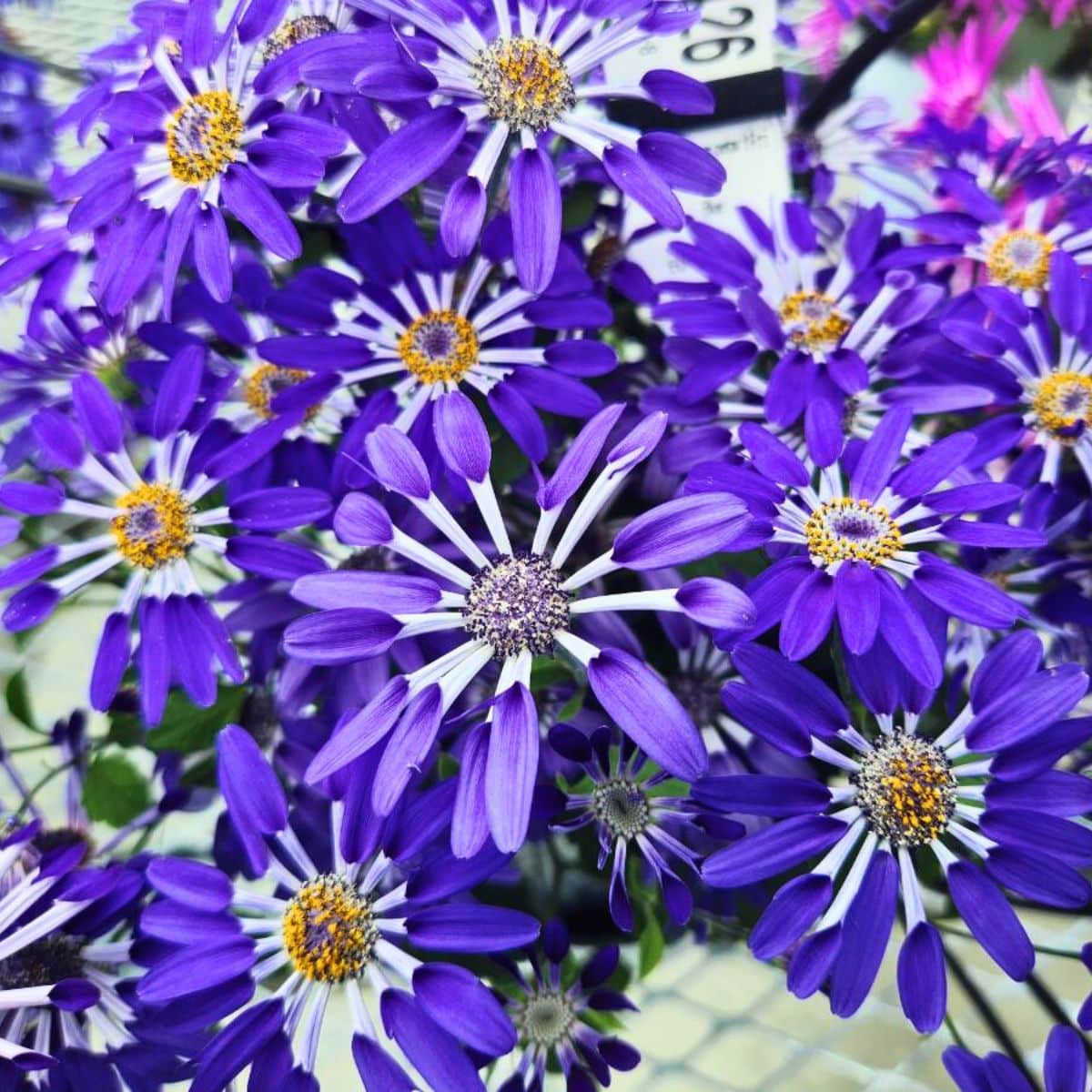
Leave a Reply